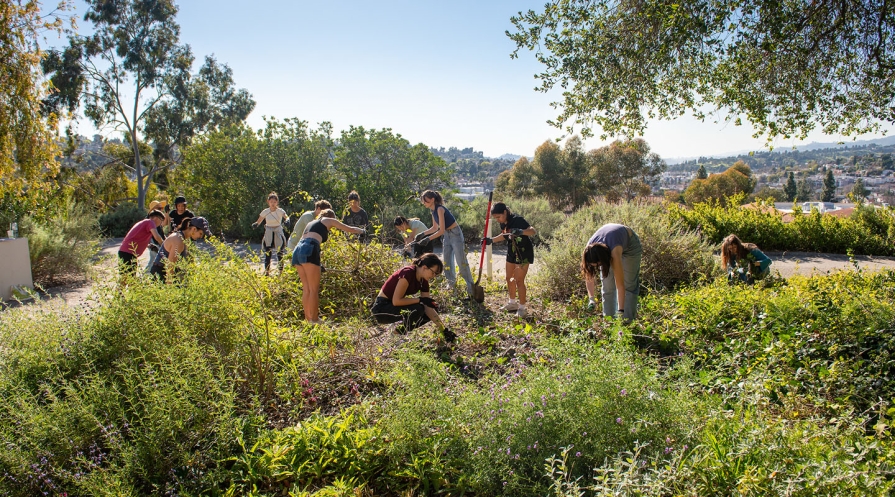
Oxy is home to a number of restoration sites where thoughtful landscaping decisions have been used in order to reduce our water consumption, provide habitat for wildlife and promote biodiversity, and make our campus more resilient in the face of a changing climate.
Contrary to popular belief, Los Angeles is not a desert! While we do have hot, dry summers, the City of LA is actually a Mediterranean climate, which means we also have mild, wet winters. Southern California has a unique mix of semi-arid, desert, Mediterranean, and mountain climates, each hosting a slightly different ecosystem. Oxy is lucky to be in a county considered to be a biodiversity hot spot, with over 4,000 distinct species of plants and animals! SoCal native landscapes such as chaparral, oak woodlands, wetlands, and riparian areas characterize Los Angeles County, and Oxy’s landscape reflects some of these key natural features on our campus. Here are a few of our latest restoration projects, in order of most to least recent.
UEPI Native Garden
In 2023, a student independent study project led to a proposal to replace the grass lawn at 1541 Campus Road, which houses the Urban and Environmental Policy Institute (UEPI), with a native garden. Graham Luethe ’26’s project earned a $13,500 grant through LADWP's Turf Replacement Program rebate. After a semester of research, Graham’s project took root over the Spring 2024 semester.
The turf replacement project at UEPI was tied into the curriculum of an Urban and Environmental Policy class, UEP 247: Urban Agriculture and Native Landscaping Practicum, with students not only learning about the importance of urban green spaces and drought-resistant plant benefits in the classroom, but participating in hands-on learning activities to turn theory into practice. Students, in collaboration with The Urban Homestead, changed the topography of the land to retain more water, planted California native plants to reduce the need for irrigation and promote biodiversity, and created educational signage for each new plant explaining its ecological and cultural role.
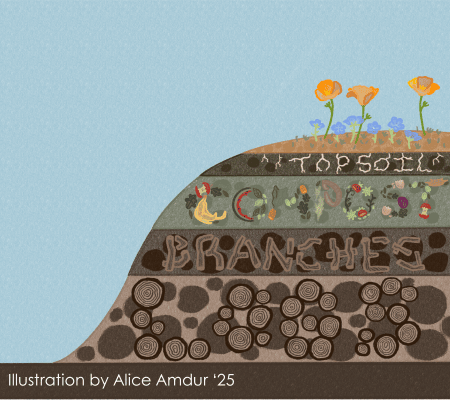
The UEPI Native Garden uses a variety of water retention methods to keep storm water in the ground supporting plant life instead of washing away into the street. A system of shallow ships (swales) and small hills (berms) allows water to absorb into the ground and replenish groundwater supply. Soaking up the water can also cool down the surrounding area, mitigating the urban heat island effect. The UEPI Native Garden created a type of berm called a hügel by using two fallen oak tree logs from Oxy's main campus to build up the berm. As the logs break down, they will slow-release nutrients to the plants, acting as a natural fertilizer.
The UEPI Native Garden features three key ecosystems within the California Floristic Province, a biodiversity hotspot, helping to restore what has been lost due to urbanization: chaparral, oak woodland, and riparian. Where there was once only one species of non-native turf grass, the site now hosts over 200 individual plants of more than 25 species. Native plants tend to have longer roots than non-native grasses that can access water deep in the ground, allowing them to go longer without irrigation or rain. This will help the plants endure hotter and drier summers once they are established. Native plant roots also have the ability to draw and store carbon from the atmosphere and soak up soil contaminants like chemicals and metals.
The garden will serve as a site for native landscaping education, featuring an outdoor classroom made of oak tree logs and interpretive signage illustrated by Biology student Alice Amdur '25. The four signs educate visitors on the story of the garden, green stormwater infrastructure methods, California's native landscapes, and acknowledging that the garden is located on the traditional, ancestral, and unceded territory of the Gabrielino/Tongva peoples.
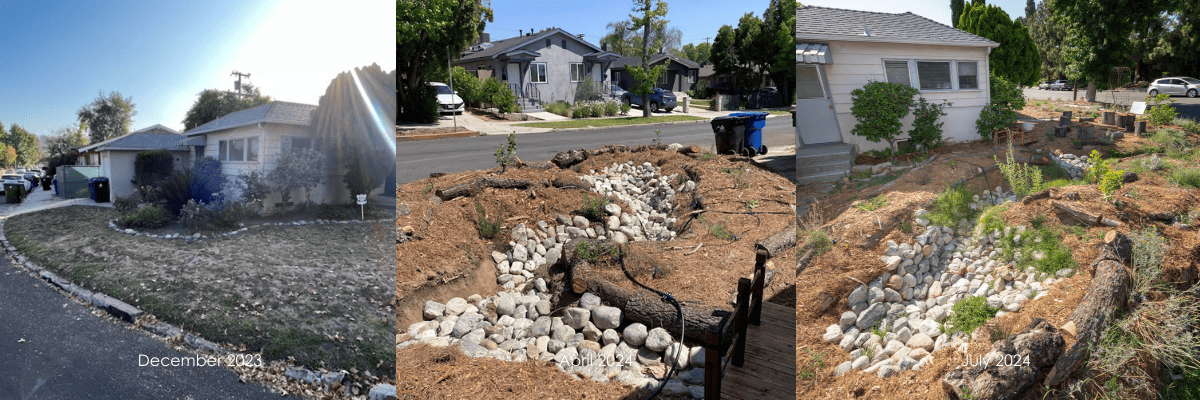
The Microforest
In the fall of 2023, Professor of Biology Gretchen North’s Plant Form and Function class, joined by about 40 volunteers from the community, broke ground on a project to plant a “microforest” on Oxy’s campus. A micro forest, designed by botanist Akira Miyawaki, “mirrors the exceptional climate resilience of thickets of indigenous trees in Japan… by densely packing small squares of land with native plants, which in turn conserves water, sequesters carbon, lowers temperatures, and reestablishes plant, fungi, and animal biodiversity.” In Los Angeles, all of these qualities are desired characteristics as we face the compounding impacts of climate change, and Oxy is not the first to adopt this concept in the city. There is a microforest in Griffith Park at the Bette Davis Picnic area, piloted by the Los Angeles Parks Foundation in 2021. Since then, a few others have popped up, including one in Ascot Hills Park just a few minutes away in El Sereno.
Oxy’s microforest features trees such as elderberry, black walnut, and a variety of oaks, which, once established, have the potential to sequester enough carbon to offset the equivalent of 650 miles driven in an average car. As the trees age, this sequestration will increase exponentially. This plays a role in our carbon footprint, acting as a “carbon sink,” absorbing some of the greenhouse gasses emitted on campus, all the while absorbing storm water and lowering the temperature of the surrounding air.
This site is home to 141 individual plants from 29 varieties of native trees, shrubs, and perennial plants, which means it is a hotspot for urban biodiversity and will attract more wildlife to campus, thereby improving our local ecosystem and allowing for even greater opportunities for students and professors to use the campus as a living laboratory.
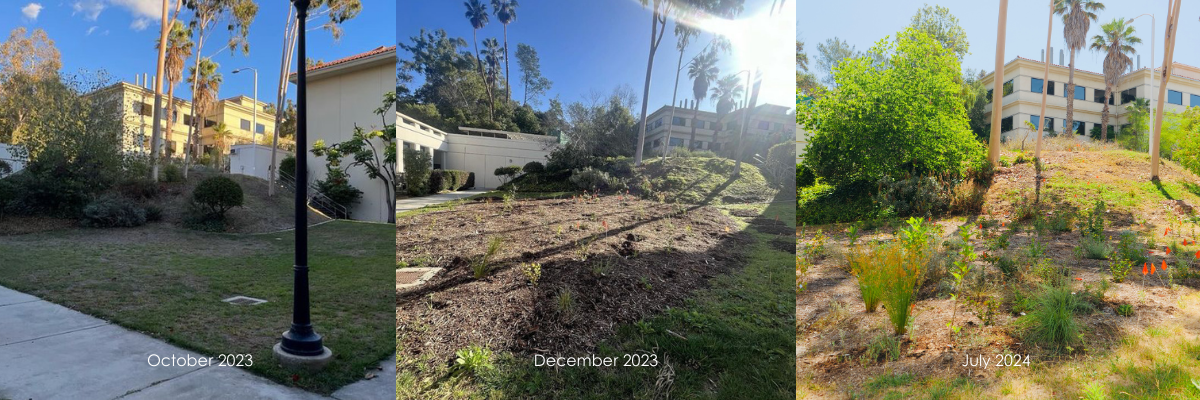
Fiji Hill
The Oxy Food, Energy, and Sustainability Team’s (FEAST) mission includes a goal to restore the 40 acres of Fiji Hill to its native habitat. Fiji Hill is located at the highest point of campus and has a 360-degree view of Northeast LA, including sites of DTLA, the San Gabriel mountains, and beyond. FEAST, which maintains a number of native restoration projects on campus, has so far planted dozens of native plants on Fiji Hill, which is also home to Oxy’s one-megawatt solar array.
Norris Pollinator Garden
Established in 2015 as a result of a collaboration between FEAST, the Oxy Biology Department, the Audubon Center at Debs Park, and Facilities Management, the Norris Native Pollinator Garden features at least nine varieties of California native plants that provide food and shelter for a diverse pollinator network, including bees, butterflies, flies, bats, and hummingbirds. Learn more about the project from this presentation by Skye Harnsberger '16.
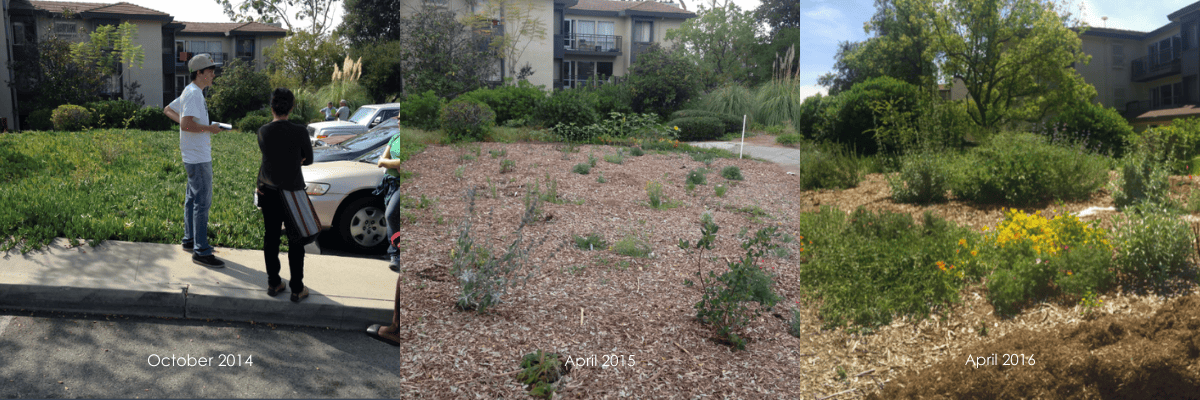
Gretchen North Coastal Sage Scrub Garden
This site, named in honor of John W. McMenamin Endowed Chair in Biology Dr. Gretchen North, was a result of a field experiment conducted by Diego Zapata ’19 in 2017. The plants, including several of the plants that characterize the Coastal Sage Scrub plant communities in California, were grown from seed in order to test differential growth rates in restoration settings.
Stewie Butterfly Garden
With a goal of providing nectar and homes for larvae for native butterfly species, the Stewie Butterfly Garden is maintained by FEAST, the “Food, Energy, and Sustainability Team.” Plants include Deerweed (Acmispon glaber), California Buckwheat (Eriogonum fasciculatum), Arroyo Lupine (Lupinus succulentus), and Narrowleaf Milkweed (Asclepias fascicularis). Insect visitors include native butterfly species like hairstreaks, blue butterflies, and monarchs.
